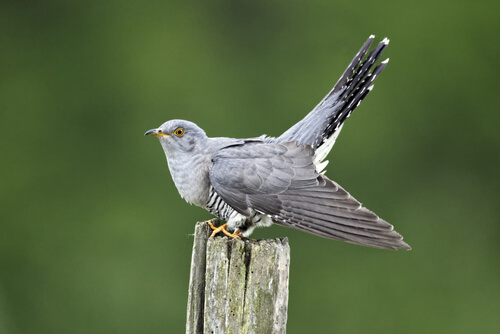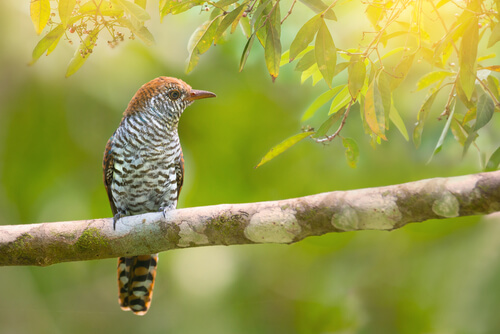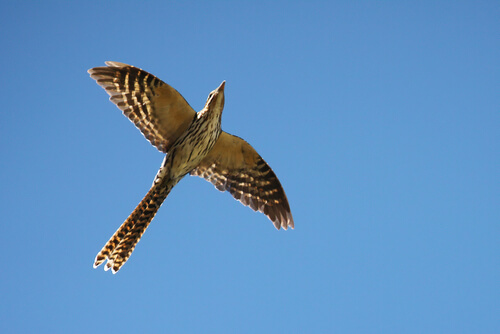
| Kingdom | Animalia |
| Phylum | Chordata |
| Class | Aves |
| Order | Cuculiformes |
| Family | Cuculidae |
| Genus | Cuculus, 25 others |
| Species | Many (i.e. Cuculus canorus) |
| Niche | Cosmopolitan Insectivore, Brood Parasite, (species dependent) |
| Length | 6-25 in (15-63 cm) |
| Weight | 0.04-1.4 lbs (17-630 g) |
| Lifespan | 6 years (common Cuckoo) |
| Social Structure | Solitary |
| Conservation Status | Least concern |
| Preferred Habitat | Forests, woodlands |
| Average Clutch Size | 1-6 eggs |
| Main Food Items and Prey | Insects |
| Predators | Coyotes, bobcats, snakes, birds of prey |
The Basics
The cuckoo is a medium-sized bird of the family Cuculidae, which includes the European cuckoo, roadrunner, and 24 other genera of slender birds. They are found throughout the world. Most are tree-dwelling, although some – such as the infamous roadrunner – spend the majority of their time on the ground.

Appearance
Cuckoo birds are generally medium-sized. The smallest species, the little bronze cuckoo, weighs only 0.03 lbs (17 g) and is about 6 in (15 cm) long. The largest species, the Channel-billed cuckoo, weighs up to 1.4 lb (630 g) and is 25 in (63 cm) long. The most well-known species, the common or European cuckoo (C. canorus), lies somewhere in the middle, at about 13 in (32 cm) long from bill to tail.
The common cuckoo is slender and has a greyish body. A red-rust, or ‘rufous’ color morph also exists in females and some juvenile males. The solid coloration extends on their frontside over their breast, where there begins a section on the cuckoos belly feathers that are ‘barred’ black and white. Its tail is long, making up about 40 percent of its overall length. While in flight its profile is reminiscent of a sparrowhawk, which they may mimic. Common cuckoos molt twice per year.
Despite the variation of traits and behaviors displayed by members of the cuckoo family, they all have some traits in common. For example, the most important distinguishing feature of the family is their feet. The two inner toes point forward while the two outer toes point backward. This is referred to as ‘zygodactyl’.
Within the family, there are two general body forms. There are ‘arboreal’ species such as the common cuckoo. These are tree-dwelling and tend to be slender with shorter feet. The other body form is that of the ‘terrestrial’ species. Including the roadrunner, these species spend their time on the ground, often running instead of flying. Unsurprisingly, they have larger feet than the arboreal species that fly much more proficiently. They also tend to be rounder and heavier than their airborne cousins, making flight an unviable option for these species.
Distribution
Being such a large family, cuckoos are widespread throughout the world. They are found on every continent besides Antarctica. Cuculinae (the brood parasite cuckoos) is the most far-flung subfamily, with species occurring across Asia, Europe, Africa, Australia, and Oceania.
Specific habitat preferences depend on the species, with arboreal species residing primarily in trees and terrestrial species living on the ground. In general, their habitats need to provide them with a source of food and a safe place to nest and breed. Most species occur in forest and woodland habitats, with many occurring in the tropics. A few species, such as the greater roadrunner, tend to inhabit less vegetated areas such as arid deserts.
Although most species tend to remain in their tropical paradise, some species make seasonal migrations while others will make partial migrations within their range. For example, species that breed in colder environments will move closer to the tropics during the winter. The long-tailed koel breeds in New Zealand but flies to its wintering grounds in Polynesia, Melanesia, and Micronesia. Here, food is less sparse than it would be in a colder clime during winter, making the migration largely worthwhile. Most cuckoo species eat various insects, with a particular preference for caterpillars.
Nesting and Reproduction
Breeding habits vary greatly within the cuckoo family. Most species are monogamous and will build their own nests in trees or bushes, while coucals – including the roadrunner – will form nests on the ground or in low-lying vegetation.
During the breeding season, common cuckoos will find a perch to settle on. Here, it raises its long tail in the air while dropping its wings at its side. Most species raise their own young, although a large minority will resort to brood parasitism. These species tend to lay just one egg in the host species’ nest. However, non-parasitic species will lay up to 6 eggs in nests of their own making.

Cuckoo species are widespread and, in general, are not threatened. Some populations may face threats from habitat destruction for human development in particular, but in general, their numbers remain strong. Most cuckoo species are least as “Least Concern” on the IUCN Red List.
Fun Facts about Cuckoo!
The interaction between Cuckoos and human culture dates back millennia, from ancient Greece to the Europe of Shakespeare to India and Japan.
The Parasite Bird
Some species, such as the common Cuckoo (C. canorus) and other members of the subfamily Cuculinae, are known as brood parasites. They will effectively ‘trick’ other species to rear their young for them. A female cuckoo finds a nest and will lay her egg in it while its owner is out hunting or defending its territory. In some cuckoo species, males will even do the bidding for the female, luring the host species away from its nest for her.

This egg will be incubated by the other bird. Once hatched, the adult bird will feed the cuckoo chick, which often pushes the other eggs or chicks from the nest and takes over. In many cases, the adult of the host species – often warblers – is much smaller than the large cuckoo chicks. However, instinct drives them to continue providing food for the chick. Fascinatingly, some of these brood parasite species’ young have cryptic plumage (feathers) at a young age and will even resemble the plumage of the host species’ chicks. Some cuckoo eggs will also mimic the eggs of the host species.
The Communal Bird
Most species of cuckoo are monogamous. However, there are some fascinating exceptions to this rule demonstrating that brood parasitism isn’t the only interesting breeding behavior within the cuckoo family.
For example, one such behavior is in many ways the opposite of brood parasitism. Some species of cuckoo such as the anis cuckoo and the guira cuckoo will lay their eggs in communal nests. All members of the group will help to build these large nests and the nests are used by all to rear their young.
Like many communal situations, however, this system isn’t completely perfect. There still exists competition between females who will even remove other eggs from the nest to lay their own.
An Advanced Repertoire
Cuckoos are known for their diverse calls and songs. As you’ve learned, they are deceptive and secretive birds, and this variety of songs allows them to communicate with others of their species. They may announce dominion over their territory in this way or attempt to attract a mate. Remarkably, these calls remain highly consistent within cuckoo species, even over vast geographical ranges. Given that many cuckoo species are raised communally, this suggests that they may innate to a species rather than learned by young birds from their parents.
